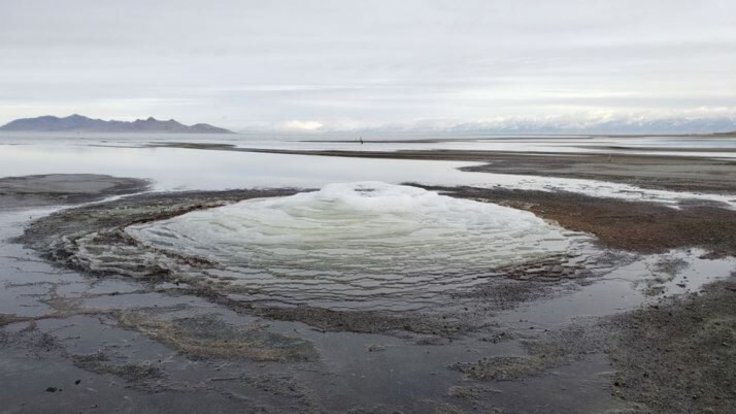Geologists and authorities at Utah's Great Salt Lake Park have discovered mounds of a rare crystalline mineral which emerged above the surface of the lake. They found four white mounds which were first noticed in October 2019 by the ranger Allison Thompson.
The ranger noticed the growth of the mirabilite formations and then asked the experts at Utah Geological Survey to provide their assistance. As per the researchers, these four white mounds are up to three feet high and dozens of feet across.
Great Salt Lake

State geologists who tested the mounds later revealed that these were made with Glauber's salt, also known as "mirabilite," which appears as white or colourless monoclinic crystals and after being exposed to dry air, it effloresces and forms a powdery anhydrous sodium sulfate. Scientists claimed that these mounds disappear with changing temperatures and the rising lake levels.
In a blog post by Utah State Parks officials, it was mentioned that researchers involved in this study interested in the precipitation of the white mounds because they may serve as analogues to similar features and conditions on Martian surface.
As per the researchers, such mounds are very rare to find on earth. As of now, only in a few places, primarily in the Arctic, scientists noticed these rare mounds. However, it should be mentioned that even though mirabilite deposits have been found beneath the waters of the Great Salt Lake earlier, this is the first time researchers noticed the mounds in this area.
Mirabilite mounds

It should be mentioned that the geologists mentioned that the mirabilite is high salinity sulfate-rich springs, which can be visible only if the lake level falls below an elevation of 4194 feet. But, after closer analysis of the Utah mounds, the scientists came to know that these are "a built-up collection of crystallized terraces, similar in appearance to the travertine rimstone and dam terraces that form at Mammoth Hot Springs in Yellowstone National Park."
In the post, the park authority also said that as the mounds grow, they seal off their spring source and the formation of a new mound will begin, a few dozen yards away.
Mirabilite mounds tour
As per the Great Salt Lake Park authorities, they are currently offering guided tours of the mirabilite mounds to visitors. So, the tourists can visit the park mounds every half-hour each day between the 10 am and 4 pm.
"Those attending a guided tour are advised to wear water-resistant or waterproof boots as the lake water and mud can rise to mid-calf," said the park authority and asked the visitors to avoid causing any damage to these mounds and not to remove the pieces of them.
Antarctic Mirabilite mounds
As per the previous discovery, researchers found such mounds on the end moraine of the Lewis Cliffs Ice Tongue in the Transantarctic Mountains, Antarctica. As per the researchers, their mineral stabilities and transformation behaviours under different temperature and relative humidity conditions have been evaluated to elucidate formation mechanism.
As per a study on the Arctic mounds, they noticed the needle-like nahcolite crystals which are "growing on the exteriors of the mounds suggest a dissolution/precipitation process involving atmospheric CO2 and water. The co-existence of nahcolite and boron-bearing minerals indicates the presence of a Na+-, HCO3 -- and boron-bearing alkaline brine, which produces qilianshanite as a secondary mineral by the reaction of nahcolite and borax in atmospheric CO2 and H2O."









